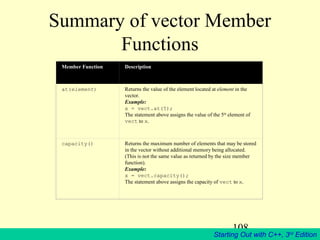This document discusses arrays in C++. It begins by explaining that arrays can hold multiple values of the same type, unlike regular variables. Different examples of array declarations and initialization are provided. The document also discusses accessing individual array elements using subscripts, and that C++ does not perform bounds checking on arrays. Processing the contents of arrays is described as being similar to regular variables. Finally, the use of parallel arrays to relate data is covered through an example of storing employee hours and pay rates in separate but corresponding arrays.
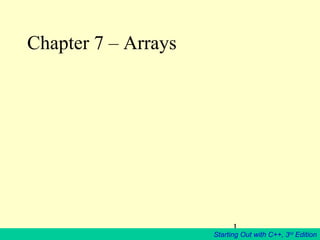
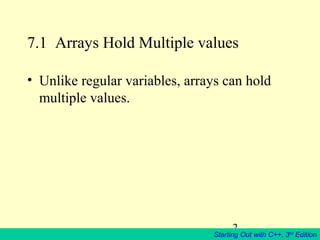


![5
Starting Out with C++, 3rd
Edition
Table 7-1
Array Declaration Number of
Elements
Size of
Each Element
S ize of the
Array
c h a r l e t t e r s [ 2 5 ] ; 25 1 byte 25 bytes
s h o r t r i n g s [ 1 0 0 ] ; 100 2 bytes 200 bytes
i n t m i l e s [ 8 4 ] ; 84 4 bytes 336 bytes
f l o a t t e m p [ 1 2 ] ; 12 4 bytes 48 bytes
d o u b l e d D i s t a n c e [ 1 0 0 0 ] ; 1000 8 bytes 8000 bytes](https://image.slidesharecdn.com/ch7-150411030147-conversion-gate01/85/Ch7-5-320.jpg)

![7
Starting Out with C++, 3rd
Edition
Program 7-1
// This program asks the user for the number of hours worked
// by 6 employees. It uses a 6-element int array to store the
// values.
#include <iostream.h>
void main(void)
{
short hours[6];
cout << "Enter the hours worked by six employees: ";
cin >> hours[0];
cin >> hours[1];
cin >> hours[2];
cin >> hours[3];](https://image.slidesharecdn.com/ch7-150411030147-conversion-gate01/85/Ch7-7-320.jpg)
![8
Starting Out with C++, 3rd
Edition
Program continues
cin >> hours[4];
cin >> hours[5];
cout << "The hours you entered are:";
cout << " " << hours[0];
cout << " " << hours[1];
cout << " " << hours[2];
cout << " " << hours[3];
cout << " " << hours[4];
cout << " " << hours[5] << endl;
}](https://image.slidesharecdn.com/ch7-150411030147-conversion-gate01/85/Ch7-8-320.jpg)
![9
Starting Out with C++, 3rd
Edition
Program Output with Example Input
Enter the hours worked by six employees: 20 12 40 30 30 15
[Enter]
The hours you entered are: 20 12 40 30 30 15](https://image.slidesharecdn.com/ch7-150411030147-conversion-gate01/85/Ch7-9-320.jpg)

![11
Starting Out with C++, 3rd
Edition
Program 7-2
// This program asks the user for the number of hours worked
// by 6 employees. It uses a 6-element short array to store the
// values.
#include <iostream.h>
void main(void)
{
short hours[6];
cout << "Enter the hours worked by six employees: ";
for (int count = 0; count < 6; count++)
cin >> hours[count];
cout << "The hours you entered are:";
for (count = 0; count < 6; count++)
cout << " " << hours[count];
cout << endl;
}](https://image.slidesharecdn.com/ch7-150411030147-conversion-gate01/85/Ch7-11-320.jpg)
![12
Starting Out with C++, 3rd
Edition
Program Output with Example Input
Enter the hours worked by six employees: 20 12 40 30 30 15
[Enter]
The hours you entered are: 20 12 40 30 30 15](https://image.slidesharecdn.com/ch7-150411030147-conversion-gate01/85/Ch7-12-320.jpg)
![13
Starting Out with C++, 3rd
Edition
Program 7-3
// This program asks the user for the number of hours worked
// by 6 employees. It uses a 6-element short array to store the
// values.
#include<iostream.h>
void main(void)
{
short hours[6];
cout << "Enter the hours worked by six employees.n";
for (int count = 1; count <= 6; count++)
{
cout << "Employee " << count << ": ";
cin >> hours[count - 1];
}
cout << "The hours you entered aren";](https://image.slidesharecdn.com/ch7-150411030147-conversion-gate01/85/Ch7-13-320.jpg)
![14
Starting Out with C++, 3rd
Edition
Program continues
for (count = 1; count <= 6; count++)
{
cout << "Employee " << count << ": ";
cout << hours[count - 1] << endl;
}
}](https://image.slidesharecdn.com/ch7-150411030147-conversion-gate01/85/Ch7-14-320.jpg)
![15
Starting Out with C++, 3rd
Edition
Program Output with Example Input
Enter the hours worked by six employees.
Employee 1: 20 [Enter]
Employee 2: 12 [Enter]
Employee 3: 40 [Enter]
Employee 4: 30 [Enter]
Employee 5: 30 [Enter]
Employee 6: 15 [Enter]
The hours you entered are
Employee 1: 20
Employee 2: 12
Employee 3: 40
Employee 4: 30
Employee 5: 30
Employee 6: 15](https://image.slidesharecdn.com/ch7-150411030147-conversion-gate01/85/Ch7-15-320.jpg)

![17
Starting Out with C++, 3rd
Edition
Program 7-4
// This program unsafely accesses an area of memory by writing
// values beyond an array's boundary.
// WARNING: If you compile and run this program, it could cause
// the computer to crash.
#include <iostream.h>
void main(void)
{
short values[3]; // An array of 3 short integers.
cout << "I will store 5 numbers in a 3 element array!n";
for (int count = 0; count < 5; count++)
values[count] = 100;
cout << "If you see this message, it means the computern";
cout << "has not crashed! Here are the numbers:n";
for (int count = 0; count < 5; count++)
cout << values[count] << endl;
}](https://image.slidesharecdn.com/ch7-150411030147-conversion-gate01/85/Ch7-17-320.jpg)
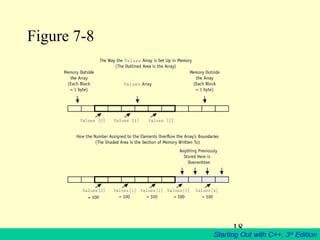

![20
Starting Out with C++, 3rd
Edition
Program 7-5
// This program displays the number of days in each month.
// It uses a 12-element int array.
#include <iostream.h>
void main(void)
{
int days[12];
days[0] = 31; // January
days[1] = 28; // February
days[2] = 31; // March
days[3] = 30; // April
days[4] = 31; // May
days[5] = 30; // June
days[6] = 31; // July](https://image.slidesharecdn.com/ch7-150411030147-conversion-gate01/85/Ch7-20-320.jpg)
![21
Starting Out with C++, 3rd
Edition
Program continues
days[7] = 31; // August
days[8] = 30; // September
days[9] = 31; // October
days[10] = 30; // November
days[11] = 31; // December
for (int count = 0; count < 12; count++)
{
cout << "Month " << (count + 1) << " has ";
cout << days[count] << " days.n";
}
}](https://image.slidesharecdn.com/ch7-150411030147-conversion-gate01/85/Ch7-21-320.jpg)

![23
Starting Out with C++, 3rd
Edition
Program 7-6
// This program displays the number of days in each month.
// It uses a 12-element int array.
#include <iostream.h>
void main(void)
{
int days[12] = {31, 28, 31, 30,
31, 30, 31, 31,
30, 31, 30, 31};
for (int count = 0; count < 12; count++)
{
cout << "Month " << (count + 1) << " has ";
cout << days[count] << " days.n";
}
}](https://image.slidesharecdn.com/ch7-150411030147-conversion-gate01/85/Ch7-23-320.jpg)

![25
Starting Out with C++, 3rd
Edition
Program 7-7
// This program uses an array of ten characters to store the
// first ten letters of the alphabet. The ASCII codes of the
// characters are displayed.
#include <iostream.h>
void main(void)
{
char letters[10] = {'A', 'B', 'C', 'D', 'E',
'F', 'G', 'H', 'I', 'J'};
cout << "Character" << "t" << "ASCII Coden";
cout << "--------" << "t" << "----------n";
for (int count = 0; count < 10; count++)
{
cout << letters[count] << "tt";
cout << int(letters[count]) << endl;
}
}](https://image.slidesharecdn.com/ch7-150411030147-conversion-gate01/85/Ch7-25-320.jpg)
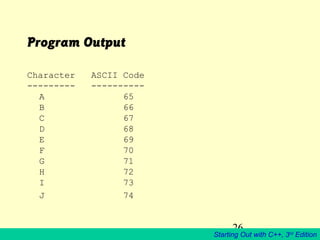
![27
Starting Out with C++, 3rd
Edition
Partial Array Initialization
• When an array is being initialized, C++
does not require a value for every element.
int numbers[7] = {1, 2, 4, 8};](https://image.slidesharecdn.com/ch7-150411030147-conversion-gate01/85/Ch7-27-320.jpg)
![28
Starting Out with C++, 3rd
Edition
Program 7-8
// This program has a partially initialized array.
#include <iostream.h>
void main(void)
{
int numbers[7] = {1, 2, 4, 8}; // Initialize the
// first 4 elements.
cout << "Here are the contents of the array:n";
for (int index = 0; index < 7; index++)
cout << numbers[index] << endl;
}](https://image.slidesharecdn.com/ch7-150411030147-conversion-gate01/85/Ch7-28-320.jpg)
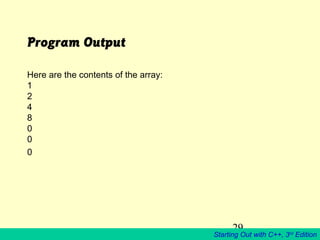
![30
Starting Out with C++, 3rd
Edition
Implicit Array Sizing
• It is possible to declare an array without
specifying its size, as long as you provide an
initialization list.
float ratings[] = {1.0, 1.5, 2.0, 2.5, 3.0};](https://image.slidesharecdn.com/ch7-150411030147-conversion-gate01/85/Ch7-30-320.jpg)
![31
Starting Out with C++, 3rd
Edition
Initializing With Strings
• When initializing a character array with a
string, simply enclose the string in
quotation marks:
char name[] = “Warren”;](https://image.slidesharecdn.com/ch7-150411030147-conversion-gate01/85/Ch7-31-320.jpg)

![33
Starting Out with C++, 3rd
Edition
Program 7-9
// This program displays the contents of two char arrays.
#include <iostream.h>
void main(void)
{
char name1[] = "Holly";
char name2[] = {'W', 'a', 'r', 'r', 'e', 'n', '0'};
cout << name1 << endl;
cout << name2 << endl;
}](https://image.slidesharecdn.com/ch7-150411030147-conversion-gate01/85/Ch7-33-320.jpg)

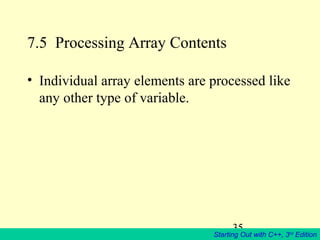
![36
Starting Out with C++, 3rd
Edition
Program 7-10
// This program stores, in an array, the hours worked by 5
// employees who all make the same hourly wage.
#include <iostream.h>
void main(void)
{
int hours[5];
float payRate;
cout << "Enter the hours worked by 5 employees who alln";
cout << "earn the same hourly rate.n";
for (int index = 0; index < 5; index++)
{
cout << "Employee #" << (index + 1) << ": ";
cin >> hours[index];
}](https://image.slidesharecdn.com/ch7-150411030147-conversion-gate01/85/Ch7-36-320.jpg)
![37
Starting Out with C++, 3rd
Edition
Program continues
cout << "Enter the hourly pay rate for all the employees: ";
cin >> payRate;
cout << "Here is the gross pay for each employee:n";
cout.precision(2);
cout.setf(ios::fixed | ios::showpoint);
for (index = 0; index < 5; index++)
{
float grossPay = hours[index] * payRate;
cout << "Employee #" << (index + 1);
cout << ": $" << grossPay << endl;
}
}](https://image.slidesharecdn.com/ch7-150411030147-conversion-gate01/85/Ch7-37-320.jpg)
![38
Starting Out with C++, 3rd
Edition
Program Output with Example Input
Enter the hours worked by 5 employees who all
earn the same hourly rate.
Employee #1: 5 [Enter]
Employee #2: 10 [Enter]
Employee #3: 15 [Enter]
Employee #4: 20 [Enter]
Employee #5: 40 [Enter]
Enter the hourly pay rate for all the employees: 12.75 [Enter]
Here is the gross pay for each employee:
Employee #1: $63.75
Employee #2: $127.50
Employee #3: $191.25
Employee #4: $255.00
Employee #5: $510.00](https://image.slidesharecdn.com/ch7-150411030147-conversion-gate01/85/Ch7-38-320.jpg)
![39
Starting Out with C++, 3rd
Edition
Program 7-11
// This program stores, in an array, the hours worked by 5
// employees who all make the same hourly wage. It then
// displays the gross pay, including any overtime.
#include <iostream.h>
// Constant for defining the array size
void main(void)
{
int hours[5];
float payRate;
cout << "Enter the hours worked by 5 employees who alln";
cout << "earn the same hourly rate.n";
for (int index = 0; index < 5; index++)
{
cout << "Employee #" << (index + 1) << ": ";
cin >> hours[index];
}](https://image.slidesharecdn.com/ch7-150411030147-conversion-gate01/85/Ch7-39-320.jpg)
![40
Starting Out with C++, 3rd
Edition
Program continues
cout << "Enter the hourly pay rate for all the employees: ";
cin >> payRate;
cout << "Here is the gross pay for each employee:n";
cout.precision(2);
cout.setf(ios::fixed | ios::showpoint);
for (index = 0; index < 5; index++)
{
float grossPay, overTime;
if (hours[index] > 40)
{
// Calculate pay for 40 hours.
grossPay = 40 * payRate;
// Calculate overtime pay.
overTime = (hours[index] - 40) * 1.5 * payRate;
// Add regular pay and overtime pay.
grossPay += overTime;
}](https://image.slidesharecdn.com/ch7-150411030147-conversion-gate01/85/Ch7-40-320.jpg)
![41
Starting Out with C++, 3rd
Edition
Program continues
else
grossPay = hours[index] * payRate;
cout << "Employee #" << (index + 1);
cout << ": $" << grossPay << endl;
}
}](https://image.slidesharecdn.com/ch7-150411030147-conversion-gate01/85/Ch7-41-320.jpg)
![42
Starting Out with C++, 3rd
Edition
Program Output with Example Input
Enter the hours worked by 5 employees who all
earn the same hourly rate.
Employee #1: 10 [Enter]
Employee #2: 20 [Enter]
Employee #3: 50 [Enter]
Employee #4: 40 [Enter]
Employee #5: 60 [Enter]
Enter the hourly pay rate for all the employees: 12.75 [Enter]
Here is the gross pay for each employee:
Employee #1: $127.50
Employee #2: $255.00
Employee #3: $701.25
Employee #4: $510.00
Employee #5: $892.50](https://image.slidesharecdn.com/ch7-150411030147-conversion-gate01/85/Ch7-42-320.jpg)

![44
Starting Out with C++, 3rd
Edition
Program 7-12
// This program stores, in two arrays, the hours worked by 5
// employees, and their hourly pay rates.
#include <iostream.h>
// Constant for defining the array size
const int numEmps = 5;
void main(void)
{
int hours[numEmps];
float payRate[numEmps];
cout << "Enter the hours worked by “ << numEmps
<< “ employees and theirn";
cout << "hourly rates.n";
for (int index = 0; index < numEmps; index++)
{
cout << "hours worked by employee #" << (index + 1);
cout << ": ";](https://image.slidesharecdn.com/ch7-150411030147-conversion-gate01/85/Ch7-44-320.jpg)
![45
Starting Out with C++, 3rd
Edition
Program continues
cin >> hours[index];
cout << "Hourly pay rate for employee #";
cout << (index + 1) << ": ";
cin >> payRate[index];
}
cout << "Here is the gross pay for each employee:n";
cout.precision(2);
cout.setf(ios::fixed | ios::showpoint);
for (index = 0; index < numEmps; index++)
{
float grossPay = hours[index] * payRate[index];
cout << "Employee #" << (index + 1);
cout << ": $" << grossPay << endl;
}
}](https://image.slidesharecdn.com/ch7-150411030147-conversion-gate01/85/Ch7-45-320.jpg)
![46
Starting Out with C++, 3rd
Edition
Program Output with Example Input
Enter the hours worked by 5 employees and their hourly rates.
hours worked by employee #1: 10 [Enter]
Hourly pay rate for employee #1: 9.75 [Enter]
hours worked by employee #2: 15 [Enter]
Hourly pay rate for employee #2: 8.62 [Enter]
hours worked by employee #3: 20 [Enter]
Hourly pay rate for employee #3: 10.50 [Enter]
hours worked by employee #4: 40 [Enter]
Hourly pay rate for employee #4: 18.75 [Enter]
hours worked by employee #5: 40 [Enter]
Hourly pay rate for employee #5: 15.65 [Enter]
Here is the gross pay for each employee:
Employee #1: $97.50
Employee #2: $129.30
Employee #3: $210.00](https://image.slidesharecdn.com/ch7-150411030147-conversion-gate01/85/Ch7-46-320.jpg)
![47
Starting Out with C++, 3rd
Edition
7.7 Thou Shalt Not Assign
• You cannot use the assignment operator to
copy one array’s contents to another.
for (int count=0; count < 4; count++)
newVal[count] = oldVal[count];](https://image.slidesharecdn.com/ch7-150411030147-conversion-gate01/85/Ch7-47-320.jpg)
![48
Starting Out with C++, 3rd
Edition
Table 7-2
Expression Value
O ld V a lu e s [ 0 ] 10 (Contents of Element 0 of O ld V a lu e s )
O ld V a lu e s [ 1 ] 100 (Contents of Element 1 of O ld V a lu e s )
O ld V a lu e s [ 2 ] 200 (Contents of Element 2 of O ld V a lu e s )
O ld V a lu e s [ 3 ] 300 (Contents of Element 3 of O ld V a lu e s )
N e w V a lu e s 8012 (Memory Address of N e w V a lu e s )
O ld V a lu e s 8024 (Memory Address of O ld V a lu e s )](https://image.slidesharecdn.com/ch7-150411030147-conversion-gate01/85/Ch7-48-320.jpg)
![49
Starting Out with C++, 3rd
Edition
7.8 Printing the Contents of an
Array
• To display the contents of an array, you
must use a loop to display the contents of
each element.
int array[5] = { 10, 20, 30, 40, 50 };
for (int count = 0; count < 5; count++)
cout << array[count] << endl;](https://image.slidesharecdn.com/ch7-150411030147-conversion-gate01/85/Ch7-49-320.jpg)

![51
Starting Out with C++, 3rd
Edition
Program 7-13
// This program demonstrates that an array element is passed
// to a function like any other variable.
#include <iostream.h>
void ShowValue(int); // Function prototype
void main(void)
{
int collection[8] = {5, 10, 15, 20, 25, 30, 35, 40};
for (int Cycle = 0; Cycle < 8; Cycle++)
ShowValue(collection[Cycle]);
}](https://image.slidesharecdn.com/ch7-150411030147-conversion-gate01/85/Ch7-51-320.jpg)

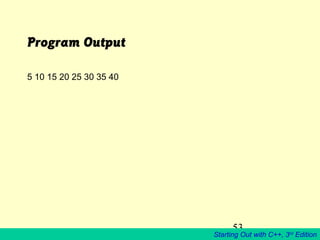
![54
Starting Out with C++, 3rd
Edition
Program 7-14
// This program demonstrates an array being passed to a function.
#include <iostream.h>
void showValues(int []); // Function prototype
void main(void)
{
int collection[8] = {5, 10, 15, 20, 25, 30, 35, 40};
showValues(collection); // Passing address of array collection
}
//***********************************************
// Definition of function showValues. *
// This function accepts an array of 8 integers *
// as its argument. The contents of the array *
// is displayed. *
//***********************************************
void showValues(int nums[])
{
for (int index = 0; index < 8; index++)
cout << nums[index] << " ";
}](https://image.slidesharecdn.com/ch7-150411030147-conversion-gate01/85/Ch7-54-320.jpg)

![56
Starting Out with C++, 3rd
Edition
Program 7-15
// This program demonstrates an array being passed to a function.
#include <iostream.h>
void showValues(int []); // Function prototype
void main(void)
{
int set1[8] = {5, 10, 15, 20, 25, 30, 35, 40};
int set2[8] = {2, 4, 6, 8, 10, 12, 14, 16};
showValues(set1);
cout << endl;
showValues(set2);
}
//***********************************************
// Definition of function showValues. *
// This function accepts an array of 8 integers *
// as its argument. The contents of the array *
// is displayed. *
//***********************************************
void showValues(int nums[])
{
for (int index = 0; index < 8; index++)
cout << nums[index] << " ";
}](https://image.slidesharecdn.com/ch7-150411030147-conversion-gate01/85/Ch7-56-320.jpg)

![58
Starting Out with C++, 3rd
Edition
Program 7-16
// This program uses a function that can display the contents
// of an integer array of any size.
#include <iostream.h>
void showValues(int [], int); // Function prototype
void main(void)
{
int set1[8] = {5, 10, 15, 20, 25, 30, 35, 40};
int set2[4] = {2, 4, 6, 8};
int set3[12] = {1, 2, 3, 4, 5, 6, 7, 8, 9, 10, 11, 12};
showValues(set1, 8);
cout << endl;
showValues(set2, 4);
cout << endl;
showValues(set3, 12);
}](https://image.slidesharecdn.com/ch7-150411030147-conversion-gate01/85/Ch7-58-320.jpg)
![59
Starting Out with C++, 3rd
Edition
Program continues
//***********************************************
// Definition of function showValues. *
// This function displays the contents of the *
// array passed into nums. The value passed *
// into elements is the number of elements in *
// the nums array. *
//***********************************************
void showValues(int nums[], int elements)
{
for (int index = 0; index < elements; index++)
cout << nums[index] << " ";
}](https://image.slidesharecdn.com/ch7-150411030147-conversion-gate01/85/Ch7-59-320.jpg)
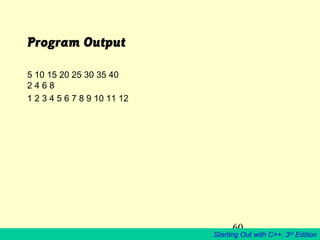
![61
Starting Out with C++, 3rd
Edition
Program 7-17
// This program uses a function that doubles the contents of
// the elements within an array.
#include <iostream.h>
void doubleArray(int [], int); // Function prototype
const int arraySize = 12;
void main(void)
{
int set[arraySize] = {1, 2, 3, 4, 5, 6,
7, 8, 9, 10, 11, 12};
cout << "The arrays values are:n";
for (int index = 0; index < arraySize; index++)
cout << set[index] << " ";
cout << endl;
doubleArray(set, arraySize);
cout << "After calling doubleArray, the values are:n";](https://image.slidesharecdn.com/ch7-150411030147-conversion-gate01/85/Ch7-61-320.jpg)
![62
Starting Out with C++, 3rd
Edition
Program continues
for (int index = 0; index < arraySize; index++)
cout << set[index] << " ";
cout << endl;
}
//**************************************************
// Definition of function doubleArray. *
// This function doubles the value of each element *
// in the array passed into nums. *
// The value passed into size is the number of *
// elements in the nums array. *
//**************************************************
void doubleArray(int nums[], int size)
{
for (int index = 0; index < size; index++)
nums[index] *= 2;
}](https://image.slidesharecdn.com/ch7-150411030147-conversion-gate01/85/Ch7-62-320.jpg)


![65
Starting Out with C++, 3rd
Edition
Program 7-18
// This program demonstrates a two-dimensional array.
#include <iostream.h>
void main(void)
{
float sales[3][4]; // 2D array, 3 rows and 4
columns.
float totalSales = 0; // To hold the total sales.
int dir, qtr; // Loop counters.](https://image.slidesharecdn.com/ch7-150411030147-conversion-gate01/85/Ch7-65-320.jpg)
![66
Starting Out with C++, 3rd
Edition
Program continues
cout << "This program will calculate the total sales ofn";
cout << "all the company's divisions.n";
cout << "Enter the following sales information:nn";
// Nested loops to fill the array with quarterly
// sales figures for each division.
for (div = 0; div < 3; div++)
{
for (qtr = 0; qtr < 4; qtr++)
{
cout << "Division " << (div + 1);
cout << ", Quarter " << (qtr + 1) << ": $";
cin >> sales[div][qtr];
}
cout << endl; // Print blank line.
}](https://image.slidesharecdn.com/ch7-150411030147-conversion-gate01/85/Ch7-66-320.jpg)
![67
Starting Out with C++, 3rd
Edition
Program continues
// Nested loops to add all the elements.
for (div = 0; div < 3; div++)
for (qtr = 0; qtr < 4; qtr++)
totalSales += sales[div][qtr];
cout.precision(2);
cout.setf(ios::fixed | ios::showpoint);
cout << "The total sales for the company are: $";
cout << totalSales << endl;
}](https://image.slidesharecdn.com/ch7-150411030147-conversion-gate01/85/Ch7-67-320.jpg)
![68
Starting Out with C++, 3rd
Edition
Program Output with Example Input
This program will calculate the total sales of
all the company's divisions.
Enter the following sales information:
Division 1, Quarter 1: $31569.45 [Enter]
Division 1, Quarter 2: $29654.23 [Enter]
Division 1, Quarter 3: $32982.54 [Enter]
Division 1, Quarter 4: $39651.21 [Enter]
Division 2, Quarter 1: $56321.02 [Enter]
Division 2, Quarter 2: $54128.63 [Enter]
Division 2, Quarter 3: $41235.85 [Enter]
Division 2, Quarter 4: $54652.33 [Enter]](https://image.slidesharecdn.com/ch7-150411030147-conversion-gate01/85/Ch7-68-320.jpg)
![69
Starting Out with C++, 3rd
Edition
Output continues
Division 3, Quarter 1: $29654.35 [Enter]
Division 3, Quarter 2: $28963.32 [Enter]
Division 3, Quarter 3: $25353.55 [Enter]
Division 3, Quarter 4: $32615.88 [Enter]
The total sales for the company are: $456782.34](https://image.slidesharecdn.com/ch7-150411030147-conversion-gate01/85/Ch7-69-320.jpg)
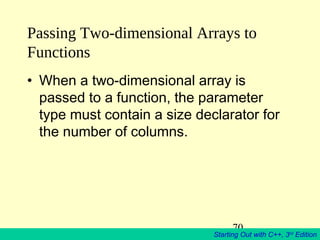
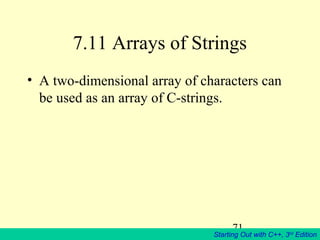
![72
Starting Out with C++, 3rd
Edition
Program 7-20
// This program displays the number of days in each month.
// It uses a two-dimensional character array to hold the
// names of the months and an int array to hold the number
// of days.
#include <iostream.h>
void main(void)
{
char months[12][10] = {"January", "February", "March",
"April", "May", "June",
"July", "August", "September”,
"October", "November","December"};
int days[12] = { 31, 28, 31, 30,
31, 30, 31, 31,
30, 31, 30, 31};
for (int count = 0; count < 12; count++)
{
cout << months[count] << " has ";
cout << days[count] << " days.n";
}
}](https://image.slidesharecdn.com/ch7-150411030147-conversion-gate01/85/Ch7-72-320.jpg)

![74
Starting Out with C++, 3rd
Edition
Three Dimensional Arrays and
Beyond
• C++ allows you to create arrays with
virtually any number of dimensions.
• Here is an example of a three-dimensional
array declaration:
float seat[3][5][8];](https://image.slidesharecdn.com/ch7-150411030147-conversion-gate01/85/Ch7-74-320.jpg)


![77
Starting Out with C++, 3rd
Edition
7.14 Introduction to the STL
vector
• A vector is like an array in the following
ways:
– A vector holds a sequence of values, or
elements.
– A vector stores its elements in contiguous
memory locations.
– You can use the array subscript operator [] to
read the individual elements in the vector](https://image.slidesharecdn.com/ch7-150411030147-conversion-gate01/85/Ch7-77-320.jpg)






![84
Starting Out with C++, 3rd
Edition
Storing and Retrieving Values in
a vector
• To store a value in an element that already
exists in a vector, you may use the array
subscript operator [].](https://image.slidesharecdn.com/ch7-150411030147-conversion-gate01/85/Ch7-84-320.jpg)
![85
Starting Out with C++, 3rd
Edition
Program 7-23
// This program stores, in two vectors, the hours worked by 5
// employees, and their hourly pay rates.
#include <iostream.h>
#include <vector> // Needed to declare vectors
using namespace std;
void main(void)
{
vector<int> hours(5); // Declare a vector of 5 integers
vector<float> payRate(5); // Declare a vector of 5 floats
cout << "Enter the hours worked by 5 employees and theirn";
cout << "hourly rates.n";
for (int index = 0; index < 5; index++)
{
cout << "Hours worked by employee #" << (index + 1);
cout << ": ";
cin >> hours[index];
cout << "Hourly pay rate for employee #";
cout << (index + 1) << ": ";
cin >> payRate[index];
}](https://image.slidesharecdn.com/ch7-150411030147-conversion-gate01/85/Ch7-85-320.jpg)
![86
Starting Out with C++, 3rd
Edition
Program 7-23 (continued)
cout << "Here is the gross pay for each employee:n";
cout.precision(2);
cout.setf(ios::fixed | ios::showpoint);
for (index = 0; index < 5; index++)
{
float grossPay = hours[index] * payRate[index];
cout << "Employee #" << (index + 1);
cout << ": $" << grossPay << endl;
}
}](https://image.slidesharecdn.com/ch7-150411030147-conversion-gate01/85/Ch7-86-320.jpg)
![87
Starting Out with C++, 3rd
Edition
Program 7-23 (continued)
Program Output with Example Input Shown in Bold
Enter the hours worked by 5 employees and their
hourly rates.
Hours worked by employee #1: 10 [Enter]
Hourly pay rate for employee #1: 9.75 [Enter]
Hours worked by employee #2: 15 [Enter]
Hourly pay rate for employee #2: 8.62 [Enter]
Hours worked by employee #3: 20 [Enter]
Hourly pay rate for employee #3: 10.50 [Enter]
Hours worked by employee #4: 40 [Enter]
Hourly pay rate for employee #4: 18.75 [Enter]
Hours worked by employee #5: 40 [Enter]
Hourly pay rate for employee #5: 15.65 [Enter]
Here is the gross pay for each employee:
Employee #1: $97.50
Employee #2: $129.30
Employee #3: $210.00
Employee #4: $750.00
Employee #5: $626.00](https://image.slidesharecdn.com/ch7-150411030147-conversion-gate01/85/Ch7-87-320.jpg)
![88
Starting Out with C++, 3rd
Edition
Using the push_back Member
Function
• You cannot use the [] operator to access a
vector element that does not exist.
• To store a value in a vector that does not
have a starting size, or is already full, use
the push_back member function. Here is
an example:
numbers.push_back(25);](https://image.slidesharecdn.com/ch7-150411030147-conversion-gate01/85/Ch7-88-320.jpg)

![90
Starting Out with C++, 3rd
Edition
Program 7-24 (continued)
for (int index = 0; index < numEmployees; index++)
{
int tempHours; // To hold the number of hours entered
float tempRate; // To hold the payrate entered
cout << "Hours worked by employee #" << (index + 1);
cout << ": ";
cin >> tempHours;
hours.push_back(tempHours); // Add an element to hours
cout << "Hourly pay rate for employee #";
cout << (index + 1) << ": ";
cin >> tempRate;
payRate.push_back(tempRate); // Add an element to payRate
}
cout << "Here is the gross pay for each employee:n";
cout.precision(2);
cout.setf(ios::fixed | ios::showpoint);
for (index = 0; index < numEmployees; index++)
{
float grossPay = hours[index] * payRate[index];
cout << "Employee #" << (index + 1);
cout << ": $" << grossPay << endl;
}
}](https://image.slidesharecdn.com/ch7-150411030147-conversion-gate01/85/Ch7-90-320.jpg)
![91
Starting Out with C++, 3rd
Edition
Program 7-24 (continued)
Program Output with Example Input Shown in Bold
How many employees do you have? 3 [Enter]
Enter the hours worked by 3 employees and their hourly rates.
Hours worked by employee #1: 40 [Enter]
Hourly pay rate for employee #1: 12.63 [Enter]
Hours worked by employee #2: 25 [Enter]
Hourly pay rate for employee #2: 10.35 [Enter]
Hours worked by employee #3: 45 [Enter]
Hourly pay rate for employee #3: 22.65 [Enter]
Here is the gross pay for each employee:
Employee #1: $505.20
Employee #2: $258.75
Employee #3: $1019.25](https://image.slidesharecdn.com/ch7-150411030147-conversion-gate01/85/Ch7-91-320.jpg)
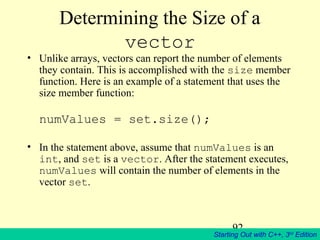
![93
Starting Out with C++, 3rd
Edition
Determining the Size of a
vector
• Example:
void showValues(vector<int> vect)
{
for (int count = 0; count < vect.size(); count++)
cout << vect[count] << endl;
}](https://image.slidesharecdn.com/ch7-150411030147-conversion-gate01/85/Ch7-93-320.jpg)
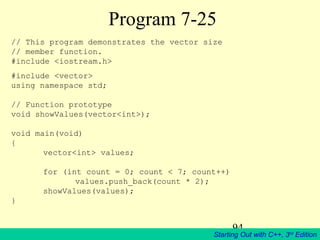
![95
Starting Out with C++, 3rd
Edition
Program 7-25 (continued)
//**************************************************
// Definition of function showValues. *
// This function accepts an int vector as its *
// argument. The value of each of the vector's *
// elements is displayed. *
//**************************************************
void showValues(vector<int> vect)
{
for (int count = 0; count < vect.size(); count++)
cout << vect[count] << endl;
}](https://image.slidesharecdn.com/ch7-150411030147-conversion-gate01/85/Ch7-95-320.jpg)
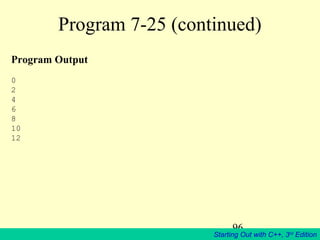
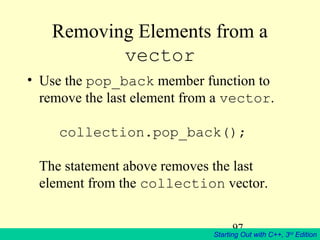








![106
Starting Out with C++, 3rd
Edition
Program 7-28 (continued)
float avgVector(vector<int> vect)
{
int total = 0; // accumulator
float avg; // average
if (vect.empty()) // Determine if the vector is empty
{
cout << "No values to average.n";
avg = 0.0;
}
else
{
for (int count = 0; count < vect.size(); count++)
total += vect[count];
avg = total / vect.size();
}
return avg;
}](https://image.slidesharecdn.com/ch7-150411030147-conversion-gate01/85/Ch7-106-320.jpg)

